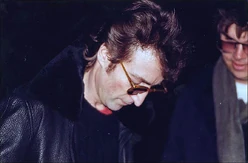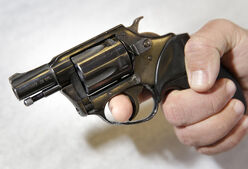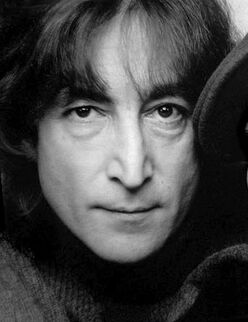| “ | Yes, I just shot John Lennon. | ” |
— Chapman
| ||
Mark David Chapman is the American stalker and assassin of British musician John Lennon.
Background[]
Chapman was born in 1955 in Fort Worth, Texas and was raised in Georgia. His father, David Chapman, was a staff sergeant in the U.S. Airforce, and his mother, Diane, was a nurse. His only sister was born seven years after him. As a child, Chapman was afraid of his father, who was physically abusive to his mother, and felt unloved by him. By age fourteen, he was bullied at school, doing drugs and skipping classes. He ran away from home once, but came back after living in the streets of Atlanta for two weeks.
Like many other teenagers, Chapman was a fan of The Beatles who idolized John Lennon and learned to play guitar because of him. However, this came to end in 1971, when Chapman became a born-again Presbyterian and he assimilated the hatred that many Christian Southerners had for Lennon after his 1966 remark that the group was "more popular than Jesus". Around the same time, a friend recommended him J.D. Salinger's young adult novel The Catcher in the Rye, and it instantly became Chapman's third personal obsession after Lennon and Religion. Chapman identified with the main character, Holden Caulfield; wished to model his life after him, and used his name or the name of the book as aliases.
Chapman followed his long-time girlfriend, Jessica Blankenship, in studying at an evangelical Presbyterian college, but he dropped out and broke with her after only a few months there. Believing himself a failure, Chapman attempted suicide in 1977 and was briefly institutionalized for clinical depression. In 1978, he made a trip around the world, and the next year, he married his Japanese-American travel agent, Gloria Abe. Some speculate that Chapman was attracted to Abe because she looked like Lennon's wife, Yoko Ono.
Murder of Lennon, Arrest, and Incarceration[]
By 1980, Chapman was resolved to kill a celebrity. He considered murdering David Bowie, Johnny Carson, Marlon Brando, Walter Cronkite, Elizabeth Taylor, George C. Scott and Jacqueline Onassis, but he eventually came again to Lennon after considering him easier to locate and meet with. He was further incensed by Lennon's song "God", in which Lennon claimed to believe in neither God nor The Beatles; and also by Anthony Fawcett's book John Lennon: One Day at a Time, which chronicled a day in the lives of Lennon and Ono in New York City. In Chapman's opinion, Lennon was a "phony" because he was wealthy while preaching a life without possessions in his song "Imagine". At one point, Chapman showed his wife a gun and bullets and told her that he was going to kill Lennon, but she did not report him.
The assassination was very disorganized. Chapman flew first to New York with the intention of killing Lennon in October 1980, despite not having a gun at the time. He later went to Atlanta, where he acquired a gun from an unwitting friend, Dana Reeves, and arrived back in New York City in November. According to Chapman, he considered committing suicide by jumping from the Statue of Liberty, after a TV set flashed the words "Thou shall not kill". On December 7, he had a random encounter with singer-songwriter James Taylor at the NYC subway, during which a very agitated Chapman pinned him against a wall and told him a confusing plan to "get in touch" with Lennon. The next morning, Chapman left his hotel and bought a copy of The Catcher in the Rye, in wich he wrote "This is my statement", and signed "Holden Caulfield" under it. He spent most of the day waiting for Lennon outside his residence in the Dakota apartment building, and at one point, he touched the hand of Lennon's five-year-old Sean when he was returning from a walk with Lennon's housekeeper. Chapman arised no suspicion because it was not unusual for Lennon's fans to wait outside to meet him; in fact, several others were there that day.

Lennon signing an autograph for Chapman, six hours before his murder.
Around 5:00 PM, Lennon and Ono left the building for a recording session. Chapman approached Lennon as they walked to their car, shook his hand, and silently handed him a copy of "Double Fantasy". Lennon signed it and asked him, "Is this all you want?", to which Chapman smiled and nodded in silence. This scene was captured by photographer Paul Goresh. The Lennons returned around 10:50 PM. After they walked past Chapman, he pulled his gun and fired five shots on Lennon's back without previous warning. Chapman made no attempt to flee and waited for police to arrest him at the scene. Other officers took the still aware Lennon to a hospital, but he died shortly after arriving there.
At the sentence hearing, Chapman rejected his defense's advice to plead not guilty by reason of insanity and pled guilty under the claim that God had instructed him to do so. He continued to promote The Catcher in the Rye in letters to newspapers, and read an extract from the book during his final statement to the court. He was sentenced to 20 years-to-life (five less than the minimum, because of his guilty plea) and to receive psychiatric treatment while imprisoned at Attica Correctional Facility outside Buffalo, New York. In 1982, the New York Supreme Court authorized the State to force-feed him with liquids after he refused to take his meals for 26 days. His wife has stayed with him and visited him every year since he was imprisoned; in spite of this, Chapman has claimed to harbor "a deep-seated resentment" towards her for not reporting him before he committed the assassination.
Chapman has been eligible for parole every two years since 2000, and been denied it in every instance; the first time, because the board considered that he was a possible threat to Ono and her son. Ono and various fans of Lennon have campaigned against Chapman's release.
Modus Operandi[]

The revolver used by Chapman to kill John Lennon, being shown by a curator.
Since Chapman only killed one victim, the term M.O. is somewhat misused. When he killed John Lennon, he shot him five times in the back with a .38 Charter Arms revolver loaded with hollow-point bullets, supposedly "because they are more deadly" and "to ensure Lennon's death". Four of them punctured his left lung and subclavian artery and would have killed him even if medical aid was instantly available. In 1990, Chapman confirmed that he had adopted the crouched position and aimed for Lennon's center of mass as he had been instructed during his training as a security guard.
Chapman stalked Lennon for three days before murdering him. It is possible that, had he not shot him on December 8, 1980, he would have done so the next day during a Broadway representation of David Bowie's The Elephant Man, for which Chapman, Lennon, and Ono had bought front row seats. Afterward, he dropped the gun and calmly removed his hat and coat to show he carried no other weapons, then waited for police while either clutching or reading from his copy of The Catcher in the Rye. When the Dakota's doorman asked if he knew what he had done, he calmly replied, "Yes, I just shot John Lennon."
Profile[]
Several psychologists and psychiatrists examined Chapman in the months before his trial. The defense's six experts believed that Chapman was psychotic; five of them diagnosed him with paranoid schizophrenia and the sixth with manic depression. The prosecution's, however, defended that his delusions fell short of psychosis and diagnosed him with different personality disorders. The court's own appointed experts leaned in favor of the prosecution, believing that he was delusional but competent to stand trial.
Known Victims[]

John Lennon in 1980.
- December 8, 1980, New York City: John Lennon, 40 (shot five times in the back; survived initially, but later died at the hospital)
Notes[]
- Chapman isn't the only assassin who had a copy of The Catcher in the Rye with him at the time he murdered his victim. Robert John Bardo had a copy with him at the time of his attack on Rebecca Schaeffer. John Hinckley, Jr.'s attack on Ronald Reagan, only four months after Chapman's, was also associated with the book.
On Criminal Minds[]
- Season One
- "L.D.S.K." - Chapman's mugshot appeared alongside the mugshots and photos of other infamous assassins.
- "Somebody's Watching" - While not directly mentioned or referenced in this episode, Chapman appears to have been an inspiration for the episode's unsub, Maggie Lowe - Both are erotomanic and mentally ill stalkers and assassins who were fixated on a celebrity, had interactions with their obsessions shortly before their attacks on them, shot their victims with revolvers, shot at least one (and Chapman's only) victim multiple times, and later attempted to kill said celebrities (though only Chapman succeeded).
- Season Two
- "The Last Word" - Chapman and his reference to The Catcher in the Rye were mentioned when it was discovered that the episode's two unsubs, the Hollow Man and the Mill Creek Killer, were using names of characters from the book as aliases when writing to each other.
- Season Eight
- "Zugzwang" - Reid brought up Chapman as an example of a violent celebrity stalker, and paraphrased him as saying after the murder: "something like, 'All of my nobodiness and all of his somebodiness collided'". This quote is an apparent creation of the show, though there have been similar lines in fictional retellings of the Lennon assassination. For example, the 2006 British movie The Killing of John Lennon had Chapman say: "I was nobody until I killed the biggest somebody on Earth."
- Season Thirteen
- "False Flag" - Chapman was mentioned again by Melissa Miller when she named him along with other criminals that were fans of the book.
Sources[]
- Wikipedia:
